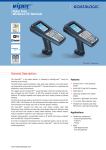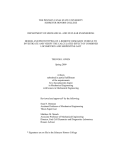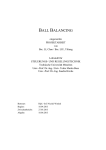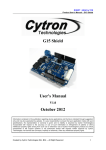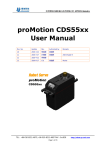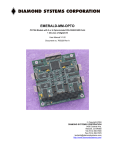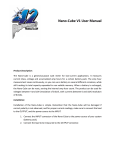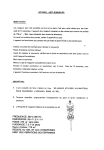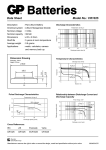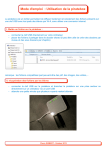Download ZIG-100
Transcript
User’s Manual 2006-07-06 Closer to Real, Zigbee Module ZIG-100 Wireless Communication ROBOTIS CO.,LTD. www.robotis.com ☏ +82-2-2168-8787 Zigbee Module ZIG-100 Contents 1. Zigbee Module ZIG-100 Page 02 2. Zigbee Setting Page 06 3. PC Interface Zig Board Schematic Page 10 1 ZIG-100 Zigbee Module 1. Zigbee Module ZIG-100 [ZIG-100 Circuit] ZIG-100 ZIG-100 is a small module that has a built-in MCU and Zigbee IC, allowing UART communication using 2.4GHz frequency. Utilized as a PAN (Personal Area Network) Module, it replaces wired serial communication with more modern wireless characteristics. Basic specifications of Zig-100 are as follows. Bandwidth RF Data Transfer Bandwidth : MAX 250kbps Interface Using UART, it can setup configuration as well as transmitting and receiving data. Various Baud Rates are supported. Recommended Baud Rate is between 9600bps and 115200bps. Power Supply Voltage of 2.7V~3.6V is normally used in ZIG-100, and for stable operation, 3.3V Regulator is recommended. The power consumption is about 30mAh in 3.3V. Take note, however, that the usage of more than 3.6V may damage the product. Dimension Width X Length X Height: 26.5mm x 19mm x 12mm (Without a connector, the height is getting lower as 6mm.) 2 ZIG-100 Zigbee Module ZIG-100 Concept As shown below, Zig-100 provides innovative wireless solution that replaces wired serial communication. Wired Serial Communication PC TxD TxD PC or RxD RxD or Embedded GND GND Embedded TxD PC After Zigbee applied PC TxD Zigbee Zigbee or RxD RxD or Embedded GND GND Embedded 3.3V 3 3.3V ZIG-100 Zigbee Module Pin Description ZIG-100 Module viewed from top. Each pin has following roles. 1 : GND - Zigbee Module’s Ground Level (0v) 2 : VCC - Zigbee Module’s Supply Voltage ( 2.7~3.6V ) 3 : LED - Zigbee Module’s LED indicating a connection status 4 : /RESET – Reset for Zigbee Module (Also used in Zigbee setting mode) 5 : CHANNEL_SEL1 - Used in Broadcasting Mode (Explained later on) 6 : CHANNEL_SEL2 7 : TXD - Zigbee Module’s Transmit Signal pin 8 : RXD - Zigbee Module’s Receive Signal pin 4 ZIG-100 Zigbee Module Setting To check or to change the setup status of the Zigbee Module, it is necessary to connect to PC as shown in page 3. Run the terminal program and set to 57600 bps, No Parity, 1 Stop Bit. Next, supplying power and transmitting “!”to Zigbee Module after reset within 60ms will change to Zigbee setup mode as shown below. (In setup mode) 5 ZIG-100 Zigbee Module 2. Zigbee Setting ZIG-100 Operation Mode Basically, Zigbee Module has a 16 bit address and each Zigbee Module has its own unique address. It can have any address between 1 and 65535; however, Address 65535 (0xFFFF) is reserved for broadcasting mode. Zigbee Module ZIG-100 has three operation modes. Each mode can be directly controlled through terminal while it is in setup mode. Refer to page 5 to go into the setup mode. Take Notes Keep in mind of following matters in setup mode. 1. Take note that only hexadecimal is used in Zigbee setup mode 2. Zigbee setup mode is always operated in 57600bps. 3. If you don’t know the Baud rate of Zigbee Module, go to 57600bps setup mode and change the Baud Rate as required. 4. In Pin Description, when you connect Status LED pin to LED, you can check the connection status with blinking of LED. 6 Zigbee Module 1:1 Mode ZIG-100 The basic operation mode of Zigbee Module is 1:1 (Peer-to-Peer) communication mode. You can change the destination address in setup mode by pressing “D” and directly inputting the destination address afterward. Take note that the destination zigbee module must also set destination address of sender in 1:1 mode. That is, if the addresses 10 and 15 wants to communicate with each other, address 10 must set destination to 15, which is 0x000F, whereas, address 15 must set destination to 10, 0x000A. A Status LED will blink when the connection is being made. After the connection is made, the LED will no longer blink and will stay on. (Destination Address Setting Example) Waiting Mode Waiting Mode is provided for connection with the unspecified Zigbee Module. It is shown in setup mode only when the destination address is not 0xFFFF. By pressing “W” it toggles “Yes” or “No” and it is in 1:1 mode when the status is “No,” and in waiting mode when it is changed to “Yes.” Waiting mode allows the connection when other Zigbee Modules try to make connection with waiting moded Zigbee Module regardless of its destination addresses. In other words, the other Zigbee Module must set destination address of waiting-moded Zigbee Module in 1:1 mode. In this case, when the Zigbee Module is in waiting mode, without any separate operation, it can form connection with other Zigbee Modules. 7 ZIG-100 Zigbee Module A Status LED will slowly blink in Waiting Mode. After connection, the LED will no longer blink and will stay on. (Waiting Mode Example) BroadCasting Mode Zigbee Module also has Broadcasting Mode that allows simultaneous connections with many Zigbee Modules. To do so, you must set the destination address to 65535(0xFFFF) first. Upon doing so, when you send a packet, all Zigbee modules that have been set as Broadcasting Mode will receive the packet. To control the chaotic traffic that might result from broadcasting, you can set four channels only through hardware setting. When you refer to page 4, you will notice CHANNEL_SEL1, 2 pins in number 5 and 6 pins. Here, you can choose four channels by configuring low/high combinations. On default when nothing is connected, it will be set to high/high by Pull-up Resistor that is embedded in Zigbee Module. A Status LED light will be on continuously in BroadCasting Mode. (In Broadcasting Mode) 8 ZIG-100 Zigbee Module Baud Rate Setting In setup mode, press “B” to set Baud Rate. Following are Baud Rate configurations. Target Baud = ( fosc / 8 ) / (x + 1 ) fosc : Main Frequency - 7.3728MHz x : divider factor Zigbee Module involves method where x (Divider Factor) is used and accordingly, use following configurations. X = ( 921600 / Target Baud ) – 1 Target Baud (bps) X (Hexadecimal) 9600 5F 14400 3F 19200 2F 28800 1F 38400 17 57600 0F 115200 07 (Baud Rate Example) (Baud Rate Setting Example.) Baud Rate between 9600~115200 bps has been tested and verified. The operation above this range of baud rate can not be guaranteed. 9 Zigbee Module ZIG-100 3. PC Interface Zig Board Schematic Interface with PC To use Zig-100 in PC, you need a simple Zig board. That is, COM Port or USB-toSerial module sends ±12V RS-232 signal and to be compatible with ZIG-100 (3.3V), it needs RS-232 Drivers/Receivers IC of either MAX232 or MAX3232. For example, below schematics illustrate MAX232, and in VCC, only 4~5.5V is allowed. In case of using regular 1.5V alkaline battery, three are needed. For Zigbee Module power, Voltage Regulator and additionally, LM1117-3.3V was used. Through the various LED blinking pattern, current status of ZIG-100 communication can be checked. 10












